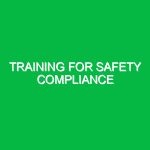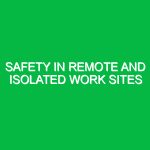Introduction
Crisis management in work environments is an essential discipline that focuses on preparing for, responding to, and recovering from unforeseen events that can disrupt operations or pose risks to health and safety. In the context of Health, Safety, and Environment (HSE), effective crisis management is vital for protecting employees, assets, and the environment. Whether it’s a natural disaster, an industrial accident, or a sudden health crisis, organizations must have robust strategies in place to mitigate risks and navigate through turbulent times. This article delves into the complexities of crisis management within HSE, highlighting potential hazards, best practices, and regulatory frameworks that guide effective response strategies.
Understanding Crisis Management in Work Environments
Crisis management involves a systematic approach to preventing or mitigating emergencies that can lead to catastrophic consequences. In work environments, especially those dealing with hazardous materials or high-risk activities, the stakes are incredibly high. The goal is to maintain operational continuity while ensuring the safety and well-being of all stakeholders involved.
A personal experience from a mining company illustrates the importance of being prepared. During a routine operation, an unexpected rockfall occurred, trapping several workers. The company had previously conducted crisis simulations, which allowed them to implement an emergency response plan swiftly. This not only saved lives but also minimized operational downtime. Such anecdotes underscore the necessity of having a well-defined crisis management strategy.
Identifying Potential Hazards and Risks
In crisis management, understanding potential hazards is imperative. The following are common risks associated with work environments, particularly in HSE:
1. Natural Disasters
Natural disasters, such as earthquakes, floods, and hurricanes, can disrupt operations and pose severe risks to worker safety. For instance, a flood can damage equipment and create hazardous conditions, necessitating immediate evacuation and recovery protocols.
2. Industrial Accidents
Industrial accidents, including chemical spills, equipment failures, and explosions, can have devastating effects. The Bhopal disaster in 1984, where a gas leak killed thousands, serves as a grim reminder of the potential consequences of inadequate crisis management in industrial settings.
3. Health Crises
The COVID-19 pandemic highlighted the importance of health crises in the workplace. Organizations faced unprecedented challenges in ensuring employee safety while maintaining productivity. Implementing health protocols became crucial for crisis management.
4. Cybersecurity Threats
In today’s digital age, cyberattacks can disrupt operations and compromise sensitive data. A breach can lead to operational paralysis and reputational damage, making cybersecurity a significant component of crisis management.
Safety Precautions and Best Practices
Implementing safety precautions and best practices is essential for effective crisis management. Here are actionable strategies that organizations can adopt:
1. Develop a Comprehensive Crisis Management Plan
A well-structured crisis management plan should outline roles and responsibilities during a crisis, communication strategies, and recovery protocols. This plan should be regularly updated and tested through simulations to ensure its effectiveness.
2. Conduct Risk Assessments
Regular risk assessments help identify potential hazards within the workplace. These assessments should involve input from employees at all levels to ensure comprehensive coverage of potential risks.
3. Train Employees
Training is crucial in preparing employees for emergencies. Regular workshops and drills can help employees understand their roles during a crisis, instilling confidence and reducing panic when a real situation arises.
4. Establish Communication Protocols
Clear communication is vital during a crisis. Organizations should develop internal and external communication plans that provide timely and accurate information to all stakeholders. This includes establishing a chain of command for decision-making.
5. Maintain Equipment and Infrastructure
Regular maintenance of machinery and infrastructure can prevent industrial accidents. Organizations should implement routine checks and ensure that safety equipment is readily available and in good working condition.
6. Foster a Safety Culture
Creating a culture of safety within an organization encourages employees to prioritize safety. Encouraging open discussions about potential hazards and safety concerns can lead to proactive measures that enhance overall safety.
Regulations and Standards Governing Crisis Management
Understanding the regulations and standards governing crisis management is crucial for organizations. Several key regulations guide HSE practices:
1. Occupational Safety and Health Administration (OSHA) Standards
OSHA provides guidelines for workplace safety, including requirements for emergency preparedness and response. Organizations must adhere to these standards to ensure employee safety and compliance.
2. ISO 22301: Business Continuity Management
ISO 22301 is an international standard that specifies the requirements for a business continuity management system. It assists organizations in preparing for, responding to, and recovering from disruptive incidents.
3. Environmental Protection Agency (EPA) Regulations
The EPA enforces regulations to protect the environment and public health. Organizations must comply with these regulations to mitigate environmental crises and avoid legal repercussions.
4. National Fire Protection Association (NFPA) Codes
The NFPA codes provide guidelines for fire safety and prevention. Compliance with these codes is essential to minimize fire-related risks in the workplace.
The Role of Leadership in Crisis Management
Effective crisis management hinges on strong leadership. Leaders play a pivotal role in shaping an organization’s response to crises. They must foster an environment where safety is prioritized, and employees feel empowered to voice concerns. Moreover, leaders should be visible during a crisis, providing reassurance and clear direction.
A notable example is the leadership displayed by the CEO of Starbucks during the COVID-19 pandemic. By swiftly implementing health and safety protocols and communicating transparently with employees and customers, the company navigated the crisis effectively while maintaining trust and loyalty.
Conclusion
Crisis management in work environments related to health, safety, and environment is not merely a reactive measure; it is a proactive strategy that can save lives and protect assets. By understanding potential hazards, implementing best practices, and adhering to regulatory standards, organizations can effectively navigate crises. The insights and strategies discussed in this article serve as a foundation for building a resilient workplace capable of withstanding unforeseen challenges. In an increasingly unpredictable world, the importance of crisis management cannot be overstated. The choice is clear: be prepared, stay informed, and prioritize safety.


